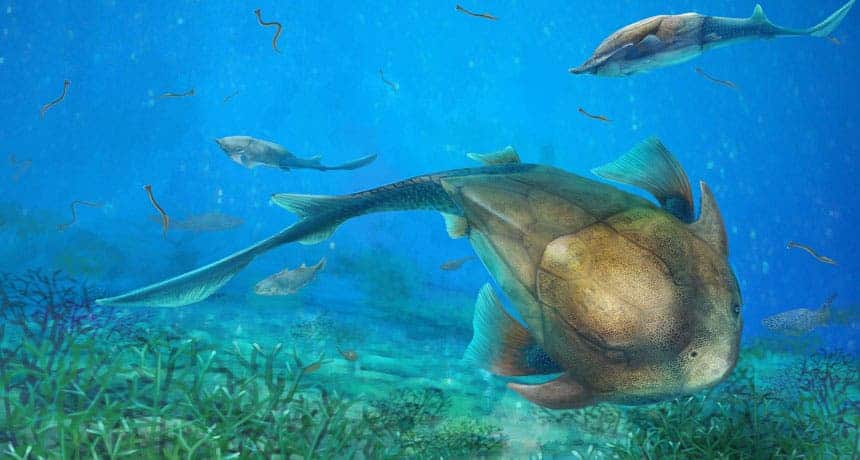
These Qilinyu fish-ancestors lived 423 million years ago, during the Silurian Period. It was discovered in China’s Yunnan province. Credit: Dinghua Yang/ Chinese Academy of Sciences
An ancient fish called Qilinyu rostrata is helping re-write early vertebrate evolutionary history, claims an international team of researchers. They found that the group the fish belongs to, called placoderms, is responsible for giving jaws to all ancient fish, and later down the evolutionary line humans too.
Previously, scientists thought placoderms were an odd group of ancient fish that eventually reached an evolutionary dead end. But in 2013, Per Ahlberg, a paleontologist at Uppsala University in Sweden, discovered a peculiar 419-million-year-old fossil called Entelognathus primordialis that had the body of a placoderm but showed the familiar three-bone jaw all vertebrates possess today. These bones are the maxilla and premaxilla of the upper jaw and the dentary of the lower jaw.
Judging from what Ahlberg and colleagues knew from fossil records, this animal should have never existed — but there it was.
“Anything from a human being to a cod has recognizably the same set of bones in the head,” Ahlberg told Science News. “Where did these bony jaws come from?”
Scientists suspected placoderms were early-jaw animals given that we’ve seen them in the fossils. Well, sort of. These looked nothing like the three-boned jaws we’re familiar with and instead resembled cutting blades.Though still debatable, most people seemed to agree that we have to look elsewhere for jaw ancestors. Finding Entelognathus .p turned this thinking upside down, but it was only one fossil. Two, however — that’s an entirely different story.
The presence of Entelognathus .p and Qilinyu r., which is four million years older, seems to suggest that all later fish owe their jaws to placoderms. Moreover, the two species form almost perfect intermediates between placoderms and bony fish, said Ahlberg.
“Now we know that one branch of placoderms evolved into modern jawed vertebrates,” study co-leader Zhu Min, a paleontologist at Chinese Academy of Sciences’ Institute of Vertebrate Paleontology and Paleoanthropology “In this sense, placoderms are not extinct.”









